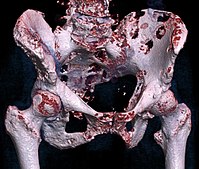
Photo from wikipedia
The effect of longer-term use of bone-modifying agent (BMA) on symptomatic skeletal event (SSE) rates in patients with bone metastases remains unclear. This retrospective study of a cohort of patients… Click to show full abstract
The effect of longer-term use of bone-modifying agent (BMA) on symptomatic skeletal event (SSE) rates in patients with bone metastases remains unclear. This retrospective study of a cohort of patients in a randomized controlled trial evaluated SSEs in patients receiving BMAs at a single cancer center. Data from patients with metastatic breast and castration-resistant prostate cancer (CRPC) were interrogated to evaluate the effects of longer-term use of BMAs on incidence, type, and risk factors for SSEs. Of 162 patients, 109 (67%) had breast cancer (BC) and 53 (33%) CRPC. Median age at diagnosis of bone metastases was 61.9 years (range 27.5–97.2) for BC patients and 72.1 (range 37.0–92.2) for CRPC patients. Median duration of BMA use was 2.3 years (range 0.1–9.9 years) for BC and 3.8 years (range 1.5–9.4) for CRPC patients. The initial BMAs in BC patients were pamidronate (46.8%), denosumab (31.2%), and zoledronate (22%). All CRPC patients received denosumab. During follow-up, 59% of BC and 75% of CRPC patients had at least one SSE. The number of patients experiencing ≥ 1 SSE per year was higher in the first year after bone metastasis diagnosis (63/162; 38.9%) compared with that in the second (26/149; 17.5%) and third years (30/123; 24.4%). Neither age, visceral disease, multiple bone metastases, nor biological markers for BC had a significant impact on time to first SSE. The risk for SSEs was greatest in the first year after diagnosis of bone metastasis. Studies evaluating de-escalation and even stopping of BMAs with longer-term use may therefore be warranted.
Journal Title: Supportive Care in Cancer
Year Published: 2022
Link to full text (if available)
Share on Social Media: Sign Up to like & get
recommendations!